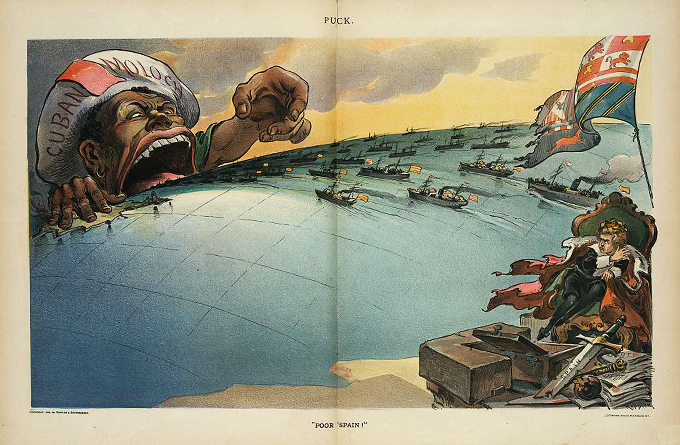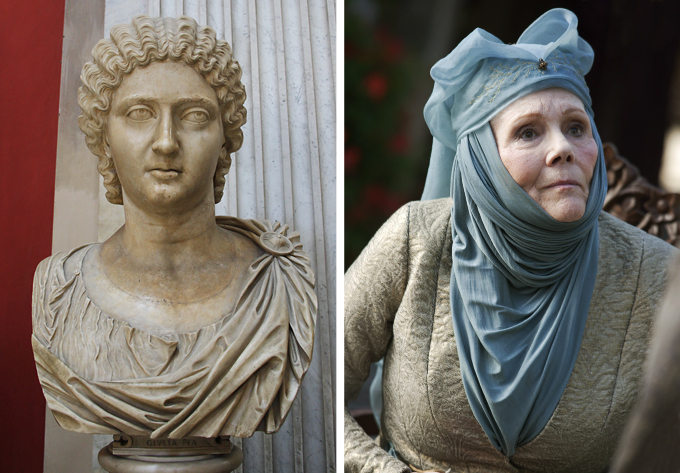
Shared posts
How Marijuana Works
Fallece Al Feldstein

En el día de ayer falleció, a los 88 años de edad, el dibujante, guionista y editor estadounidense Al Felstein, figura clave de la historia del cómic a nivel mundial.
El nombre de Feldstein está unido indisolublemente al de la editorial que ayudó a reflotar y alcanzar la fama en los años 50 del pasado siglo, EC Comics, con importancia histórica tanto por la publicación de su conocida línea de cómics de ciencia ficción, horror, guerra y crimen, como por ser la impulsora de la revista MAD. EN EC Feldstein aportó no solo su talento como dibujante –envarado, tenso, desagradable–, sino una extraordinaria capacidad inventiva que le sirvió para guionizar –muchas veces en colaboración con Bill Gaines, propietario de la editorial– buena parte de las historias que publicaban. Además, dado su carácter disciplinado y metódico, llegó muy pronto a ser editor de varias de las revistas de la editorial, trabajando codo con codo con algunos de los mejores de la época, como Johnny Craig, Wally Wood o Jack Davis.
Feldstein entró en contacto con EC en 1948, respondiendo a un anuncio de la editorial en el que requerían nuevos talentos para relanzar sus líneas de cómics. Contaba tan solo con 22 años y la experiencia adquirida desde los 15 en el estudio de Jerry Iger y Will Eisner y posteriormente en Fox Comics, donde además de dibujo fue editor de un par de títulos. Rápidamente entabló amistad con Gaines, logrando que en muy poco tiempo se le permitiese no solo dibujar, sino guionizar y editar. Gaines y Feldstein establecieron un sistema de trabajo que les permitía guionizar prácticamente todo lo que publicaba la editorial: el primero pasaba las noches en vela ideando argumentos y adaptando cuentos literarios, y a la mañana siguiente ambos se ponían manos a la obra para dar forma definitiva a los guiones, cuyos textos Feldstein imprimía directamente en las páginas en blanco que entregaban a los artistas para dibujar. Feldstein también fue el responsable de reclutar para la editorial a dibujantes tan relevantes en su devenir como Jack Davis, Jack Kamen, Joe Orlando o George Evans.
También fue el impulsor del volantazo que colocó a EC en un lugar de privilegio: hasta su llegada, la editorial había publicado cómics religiosos o había tratado de medrar al rebufo de las modas imperantes. Sin embargo, fue una propuesta de Feldstein la que hizo que EC crease –y convirtiera en una nueva tendencia– un nuevo género, el terror. Así es como relataba el propio Feldstein que convenció a Gaines: “Coges Saddle Justice y lo conviertes en Saddle Romances sólo porque Simon y Kirby han sacado una serie de romance y funciona bien. Vamos a seguirles y después hundirnos cuando se colapse, como se colapsaron las series de adolescentes. ¿Por qué no hacemos que nos sigan ellos a nosotros? Comencemos nuestra propia tendencia”. La nueva tendencia, obviamente, se denominó new trend.
Muchos han visto aquellos cómics de EC de la primera mitad de los años 50 como un antecedente o una inspiración del cómic underground que se desarrollaría en el país poco más de una década después, lo cual no es extraño, ya que a la calidad de los dibujantes se sumaba un elevado nivel de truculencia y, no menos importante, cierto regusto de denuncia social. Según Feldstein: “estar concienciado socialmente no es algo que sólo suceda hoy en día. Salíamos de la Segunda Guerra Mundial y todos teníamos grandes esperanzas sobre el maravilloso mundo del mañana. Y cuando empezamos a escribir nuestros cómics, supongo que una de las cosas que había en nuestra cabeza era hacer un poco de proselitismo en términos de conciencia social. De manera que Bill y yo tratamos de incluir, sobre todo en nuestros cómics de ciencia ficción pero creo que también lo hicimos en los de horror, lo que llamábamos historias con moralina, nuestro propio término para una historia que incluía una especie de llamamiento para mejorar nuestros estándares sociales”. Feldstein fue guionista, por ejemplo, de “Master Race“, una historia dibujada por Bernard Krigstein que fue reivindicada –por muchos motivos– por generaciones posteriores, y también escribió “Judgement Day“, dibujada por Joe Orlando, una historia contra la segregación protagonizada por un astronauta negro… motivo por el cual tuvo problemas de censura.
Una vez desaparecida la línea completa de la new trend debido a los problemas por todos conocidos –la cruzada contra la violencia en el cómic promovida por los senadores Robert Hendrickson y Estes Kefauver, avalados por el psiquiatra Fredric Wertham– y tras la marcha de Harvey Kurtzman de la editorial, Feldstein se convirtió en el editor de MAD, cargo que desempeñaría a lo largo de 29 años. Bajo su dirección, MAD fue, sin duda alguna, una de las revistas más influyentes en los Estados Unidos a lo largo de varias décadas. Tras retirarse, y durante las tres últimas décadas, Feldstein se dedicó a la pintura.
A continuación enlazamos algunos artículos relevantes sobre Feldstein y/o EC, así como algunas de las historias en las que colaboró.
Enlaces
- Entrevista con Feldstein en The Comics Journal
- EC, paradigma del horror pre code
- Coloquio con Bernard Krigstein, Harvey Kurtzman y Wally Wood
- Entrevista con Al Williamson
- Entrevista con John Severin
- Carta de rechazo de MAD, firmada por Feldstein
- Y, con todo el cariño, parecidos razonables: Al Feldstein Vs Manolo Escobar
Historias
- The Creekmore curse (1948), de Al Feldstein.
- Machine-gun mad mobsters (1948), de Al Feldstein.
- I was jilted and had no desire to live (1949), de Al Feldstein y Graham Inglels.
- I fight crime y Hate (1949), de Al Feldstein y Johnny Craig.
- The strange couple (1950), de Al Feldstein.
- It was the monster from the fourth dimension (1951), de Al Feldstein.
- The maidens cried (1951), de Al Feldstein y Wally Wood.
- Spawn of Venus (1951), de Al Feldstein.
- The patriots (1952), de Al Feldstein y Jack Davis.
- Sctrictly bussiness! (1952), de Al Feldstein y Joe Orlando.
- Kickback! (1952), de Al Feldstein y Jack Kamen.
- The small assassin! (1953), de Ray Bradbury, Al Feldstein y George Evans.
- The night before Christmas (1953), de Al Feldstein y Will Elder.
- Foul play (1953), de Al Feldstein y Jack Davis.
- King of the grey spaces (1953), de Al Feldstein, John Severin y Will Elder.
- The precious years (1953), de Al Feldstein y Wally Wood
- Judgement day (1953), de Al Feldstein y Joe Orlando.
- King of the grey spaces! (1953), de Al Feldstein, John Severin y Bill Elder.
- My world (1953), de Al Feldstein y Wally Wood.
- Sucker bait (1953), de Al Feldstein y Graham Ingels.
- Model nephew (1953), de Al Feldstein y Jack Davis.
- There will come soft rains… (1953), de Al Feldstein y Wally Wood.
- The million year picnic (1953), de Al Feldstein, John Severin y Will Elder.
- Mars is heaven (1953), de Al Feldstein y Wally Wood.
- The killer (1953), de Al Feldstein y Reed Crandall.
- Brain-Child (1953), de Al Feldstein y Al Williamson.
- The flying machine (1954), de Al Feldstein y Bernard Krigstein.
- Li’l Melvin (1954), de Al Feldstein y Will Elder.
- Come back, little Linda (1954), de Al Feldstein y George Evans.
- Squeeze play (1954), de Al Feldstein y Frank Frazetta.
- Operation friendship (1954), de Al Feldstein y Jack Davis.
- Murder the husband (1954), de Bill Gaines, Al Feldstein y Jack Davis.
- Crime Iluustrated #1 (1955), de Al Feldstein, Bernard Krigstein, Reed Crandall, Jack Oleck, Joe Orlando, Richard Smith, Graham Ingels, John Larner y George Evans.
- The sucker (1955), de Al Feldstein y Reed Crandall.
- Reflection of death (1955), de Al Feldstein y George Evans.
- The Yellow Claw (1956), de Al Feldstein y Joe Maneely.
El TSXG tumba el «nuevo orden» que creó Conde Roa en Santiago
«Hacemos algo diferente, unimos la técnica del sushi con el producto gallego»
Os xitanos toman a xustiza pola súa conta
[Libros que nos inspiran] ‘En el mapa’ de Simon Garfield: de cómo el mundo adquirió su aspecto
 No importa lo complicado que sea, no importa lo grande que sea. Aunque desplegarais un enorme mapa del mundo donde aparecerian reflejados todos los países del mundo, incluso así, podríais usar sólo 4 colores para diferenciar los países entre sí. La demostración científica de este hecho quedó sin discusión gracias a los matemáticos Wolfgang Haken y Kenneth Appel, cuando en 1976 combinaron una mezcla de todos los intentos pasados con un superordenador.
No importa lo complicado que sea, no importa lo grande que sea. Aunque desplegarais un enorme mapa del mundo donde aparecerian reflejados todos los países del mundo, incluso así, podríais usar sólo 4 colores para diferenciar los países entre sí. La demostración científica de este hecho quedó sin discusión gracias a los matemáticos Wolfgang Haken y Kenneth Appel, cuando en 1976 combinaron una mezcla de todos los intentos pasados con un superordenador.
Y de esto y de mucho más trata En el mapa, de Simon Garfield:
Los mapas nos fascinan porque cuentan historias. Los que veremos en este libro nos dicen cómo se originaron los mapas, quiénes los trazaban, qué pensaban y cómo los usamos. Por supuesto, como cualquier mapa, la elección es extremadamente selectiva, pues un libro sobre mapas en realidad es un libro sobre el progreso del mundo: barcos más robustos en el siglo XV, la triangulación a finales del siglo XVI, el cálculo de la longitud en el XVIII, los vuelos y la observación aérea en el XX. Y ahora, en este siglo, Internet, el GSP y la navegación por satélite, y, quizá, gracias a ellos, una segunda reconfiguración de nuestras habilidades espaciales.
Por ello, Garfield nos ha inspirado para escribir artículos como:
-Las decenas de islas que no existen a pesar de que aparecen en los mapas
-Cinco cosas increíbles sobre la Biblioteca de Alejandría: el centro del saber del mundo antiguo
-¿Dónde vives si eres pobre o delincuente?
Editorial Taurus
Colección: Taurus Pensamiento
Publicación: 09/10/2013
ISBN: 9788430607112
Sitio Oficial | Ficha en Taurus
-
La noticia [Libros que nos inspiran] ‘En el mapa’ de Simon Garfield: de cómo el mundo adquirió su aspecto fue publicada originalmente en Xatakaciencia por Sergio Parra.
¿Cómo ganar a tu oponente en el juego 'Piedra, papel o tijera'?
 El popular juego "Piedra, papel o tijera" se conoce en todo el mundo: en Japón, se llama Jan-ken-pon; en California, Ro-sham-bo, en Corea, Kai-bai-bo, en Sudáfrica, Ching-chong-cha. En muchas ocasiones, se usa para determinar a quién le toca llevar a cabo una tarea poco apetecible, porque se entiende que, esencialmente, el juego está determinado por el azar. Como lo de escojer la pajita más corta.
El popular juego "Piedra, papel o tijera" se conoce en todo el mundo: en Japón, se llama Jan-ken-pon; en California, Ro-sham-bo, en Corea, Kai-bai-bo, en Sudáfrica, Ching-chong-cha. En muchas ocasiones, se usa para determinar a quién le toca llevar a cabo una tarea poco apetecible, porque se entiende que, esencialmente, el juego está determinado por el azar. Como lo de escojer la pajita más corta.
Sin embargo, tras el juego hay un patrón oculto que puede explotarse para obtener cierta ventaja sobre tus oponentes. Al menos es lo que sugiere un estudio realizado por Wang Zhijian y sus colegas de la Universidad de Zhejiang, en China.
En principio, la estrategia más eficaz consiste en escoger nuestra arma de ataque al azar: si elegimos las tres acciones con la misma probabilidad en cada ronda, entonces también tendremos las mismas probabilidades de ganar, perder o empatar. Pero Zhijian sugiere que en realidad no existe tal aleatoriedad y que la gente se conduce por un patrón que podemos explotar en nuestro beneficio.
Para probarlo, Zhijian llevó a cabo diversos experimentos con 360 estudiantes reclutados en la Universidad de Zhejiang y divididos en 60 grupos de seis jugadores. En cada grupo, los jugadores jugaron 300 rondas de Piedra-Papel-Tijeras unos contra otros, registrándose cuidadosamente todos los movimientos.
Como incentivo, los ganadores eran recompensados económicamente en proporción al número de sus victorias. Para probar cómo este incentivo influyó en la estrategia, Zhijian varió los pagos para los diferentes grupos.
.jpg) Los resultados revelan un patrón sorprendente de comportamiento. En vez de guiarse por un comportamiento aleatorio, los jugadores que ganaban tendían a seguir con la misma acción, mientras que los perdedores cambiaban a la siguiente acción en una dirección a la derecha, donde Piedra → Papel → Tijera es hacia la derecha).
Los resultados revelan un patrón sorprendente de comportamiento. En vez de guiarse por un comportamiento aleatorio, los jugadores que ganaban tendían a seguir con la misma acción, mientras que los perdedores cambiaban a la siguiente acción en una dirección a la derecha, donde Piedra → Papel → Tijera es hacia la derecha).
En el ámbito de la teoría de juegos, esto se conoce como respuesta condicionada. Las implicaciones de tal estrategia son interesantes a nivel psicológico, y Zhijian aspira a estudiar en mayor profundidad la razón de que se produzca esta tendencia. Pero, de momento, la rentabilidad práctica es obvia: tenedlo en cuenta la próxima vez que os apostéis algo al "Piedra, papel y tijera".
Pero ¿cómo empezar el juego? ¿Qué posición es la más poderosa? La gente tiene tendencia a elegir Piedra. Por eso los jugadores deberían empezar con Papel para ganar.
Foto | Orgullomoore | Sertion
-
La noticia ¿Cómo ganar a tu oponente en el juego 'Piedra, papel o tijera'? fue publicada originalmente en Xatakaciencia por Sergio Parra.
A Eulogy for Twitter
Financial aspects, over the last few days:
Reuters: "Wall Street remains divided over Twitter as the seven-year-old company prepares to unveil only its second set of quarterly numbers on Tuesday. Eleven of 31 investment analysts polled by Thomson Reuters rate it a 'sell', outnumbering the seven who deem it a 'buy'. The rest have a hold rating or its equivalent."
Forbes: "The problem is that most investors and advertisers alike still don't understand that Twitter isn't Facebook and never will be - and that that may very well be a good thing."
Salon: "When your growth in user numbers starts to slow before you are anywhere near sniffing a profit, investors get worried. Even worse, the growth in 'timeline views' - the number of times Twitter users check into Twitter to see what people are saying - is lagging the growth in user numbers. In 2014, total activity still hasn't matched its 2013 peak."
Quartz: "But the most alarming figure is that Twitter generated $1.44 in advertising revenue for every 1,000 timeline views, down from $1.49 in the previous quarter. That's the best measure of the company's ability to make money from its existing base of users, and it's going in the wrong direction."
Motherboard: "Trend Junky's articles and slideshows, with titles like Celebrity Prom Pictures and ObamaCare Facts for Young Adults, draw traffic from MyTurnOns and other accounts directly controlled by Quisenberry and from an affiliate network of about 175 Twitter users. They promote the site's content for a share of ad revenue."
"I think I'm an okay writer, but a very good storyteller."
'I think what hooks people into my stories is the pace. I try to leave out the parts people skip. I used to live across the street from Alexander Haig, and if I told you a story that I went out to get the paper and Haig was laying in the driveway, and then I went on for 20 minutes describing the architecture on the street and the way the palm trees were, you'd feel like "Stop with the description--what's going on with Haig?" I tend to write stories the way you'd tell them. I think it'd be tragic if everybody wrote that way. But that's my style. I read books by a lot of great writers. I think I'm an okay writer, but a very good storyteller.'
18 Books That Changed How We Felt About Ourselves As Women
The Silence of the Fannibals
The product of television auteur Bryan Fuller, the show's thoughtfulness and depth has also inspired some of the most creative commentary in recent network TV history. The program rewards deep analysis when viewed through the lens of such concepts as evolution and economics; it even inspires detailed analysis of its costume design.
It also inspires flailing in all forms, from poetic tag-spiraling on tumblr, to passionately insane recaps, to nail polishes and weekly vegan eyeshadows and a wide array of t-shirts. The most common cure for this among many fans is considering various aspects of the show from a decidedly more irreverent angle. Hulu even got into the spirit on April Fool's Day this year.
The fanbase (called Fannibals) is fierce and dedicated, going so far as to flood any available online poll and organize grassroots word-of-mouth campaigns. The show is also a hit in many places outside the US, though some of the international promos could be mistaken for the aforementioned "irreverent" fan videos. Much of the show's fanbase is located on Tumblr, and the NBCHannibal official Tumblr is shockingly in tune with the gleefully obsessive (and ridiculous) fandom.
The show's cast and crew are very engaged with fans as well. The AV Club did a few episode walkthroughs with Bryan Fuller last year, but for this new season Fuller has committed to doing a new one for every episode. Actor Scott Thompson has been doing a supremely charming series of interviews with other cast members and some of the crew. He even interviewed a Fannibal! Even the show's amazing food stylist Janice Poon has gotten into the act with her fantastic blog where we find out how the literal sausage is made. When the fandom took a mysterious turn into obsession with flower crowns, no one was more willing to play along with the fandom than co-star Hugh Dancy. Except maybe the rest of the cast and crew.
All of this, in addition to cast and crew livetweeting right along with the showrunner. Various characters have participated as well, with accounts such as Freddie Lounds, the Dire Ravenstag, Winston the dog, the live starling that flew out of a dead woman's chest, and even Hannibal's tie.
If all of this doom and gloom and grand operatic psychodrama and gore is too much for you, you can always take a break with the Will Graham Has A Nice Day tumblr, featuring stories about Will Graham just having a nice day, with lots of puppies, and no food that is people.
Do you need more fandom ridiculousness? Of course you do!
There's even podcasts! Including an episode of the Nerdist with the man himself, Bryan Fuller.
Most of the links in this post are INCREDIBLY spoilery up to what's currently aired. For those interested in catching up, the first season is currently free for Amazon Prime members, while a portion of the second season that's aired to date is currently viewable on NBC's site. The UK is braced this week for the series to air on Sky Living, where the true zealots are looking forward to evangelizing their friends.
This post was the design of showbiz_liz, Pendragon, sparkletone, tel3path, jeather, Stacey, and mountmccabe. The awesome is all their fault. Any borked links, misspellings, omissions, or other flaws are mine.
Joffrey es Alfonso XIII (y otras teorías poco descabelladas sobre Juego de Tronos)
Atención, que vamos a jugar al Quién es quién.
Es joven, es mujer y es la benjamina de una gran familia real.
¿No? Le daremos tres pistas más.
Una, que su estirpe gobernó durante siglos el reino más extenso del mundo. Dos, que los enemigos de la misma asesinaron a su padre, el monarca, y a su heredero varón, y que también la reina y sus hermanos mayores fueron masacrados. Y tres, que ella sobrevivió milagrosamente al baño de sangre, ocultando su identidad y abandonando el país, y que reapareció ante los ojos del mundo cuando era adulta.
¿De qué personaje se trata?
Si es usted seguidor de Juego de Tronos lo tendrá claro: es Daenerys Targaryen, khaleesi consorte y única hija superviviente del rey Aerys II, el último Targaryen que se sentó en el Trono de Hierro. Y si nos relajamos con la literalidad de los detalles, incluso podría tratarse de Arya Stark.
Pero si no sigue usted Juego de Tronos lo tendrá claro también: estamos hablando de Anastasia Romanov, la hija menor del último zar ruso, que sobrevivió a la matanza de su familia y reapareció en su madurez reclamando para sí el título de única y verdadera zarina. Al menos, en la versión romántica de la historia.

Anastasia Romanov (DP / Library of the Congress) y Emilia Clarke como Daenerys Targaryen (HBO / Canal +).
Y las dos respuestas son correctas, que es algo muy sano que ocurre de vez en cuando. Aunque la gran inspiración Juego de Tronos es la Guerra de las Dos Rosas —que enfrentó en el siglo XV a las casas Lancaster y York, trasuntos respectivamente de los Lannister y los Stark, por el trono de Inglaterra—, lo cierto es que los azares trazados por George R. R. Martin en su Canción de hielo y fuego incorporan muchos otros referentes reales más allá del conflicto. Y reales en las dos acepciones del adjetivo, porque se inspiran en hechos que ocurrieron en realidad y porque lo hicieron en el seno de las familias reales europeas.
¿Sabemos cuáles son? A veces sí, porque Martin las confiesa con cuentagotas y porque también cuela pequeñas pistas de vez en cuando. En otras ocasiones son los hechos de la ficción los que evidencian su deuda clara con un referente real, como el Muro de Adriano respecto al Muro del Norte, la Cena Negra de la que fueron víctimas los Douglas de Escocia con la Boda Roja en la que se asesinó a varios Stark, el histórico enfrentamiento entre las casas Percy y Neville de Inglaterra con el de los Stark y los Lannister o el matrimonio de Enrique VI y Margarita de Anjou, considerado con frecuencia el modelo que sigue el de Robert Baratheon y Cersei Lannister. Por citar solo algunas de las deudas más evidentes.
En una gran mayoría de ocasiones, sin embargo, los personajes y giros de Juego de Tronos resuenan en la historia real solo genéricamente, lo que no significa que menos sino que de forma menos evidente. La remezcla, en palabras del propio Martin, no es «enormemente original» pero sí resulta en algo singular, que es lo que el autor pone de relieve. «En Canción de Hielo y Fuego cojo material de la Guerra de las Rosas y otras cosas de fantasía», aseguraba en una entrevista publicada hace solo unos días, «y todo ello da vueltas en mi cabeza para cuajar de algún modo lo que, espero, entonces ya es propio y único».
Hasta qué punto son conscientes estas incorporaciones solo él lo sabe, pero siempre es divertido especular, que es precisamente lo que vamos a hacer hoy. Si le turba la idea de que las tramas de Juegos de Tronos pecan de hiperbólicas y poco realistas, le proponemos un breviario de referentes con algunas hipótesis nada descabelladas sobre qué pudo pasar por la cabecita de Martin para parir semejante culebrón de traiciones, matanzas y perversiones. Verá que la realidad, como se dice en estos casos, supera ampliamente a la ficción.
(A partir de aquí incurriremos en algún SPOILER y nos referiremos a las tramas televisivas, cuyos detalles pueden diferir de la versión literaria, y solo hasta el punto al que ha avanzado la serie)
Amantes bandidos en la Edad Media
Empezando por la idea que más le rechina seguramente al espectador contemporáneo, la de que los monarcas medievales podían practicar discretamente la homosexualidad. Si cree que es una licencia, se equivoca.
En Juego de Tronos es Renly Baratheon, monarca autoproclamado de los Siete Reinos, quien mantiene una relación en estas condiciones con Loras Tyrell, delfín de una casa noble afín a la propia, y lo hace caballero de su guardia personal. El affaire se trata con sutileza en las novelas originales y de forma explícita en la televisión, pero no debe tomarse como algo extemporáneo. De hecho, tiene un precedente claro en la prolongada relación que mantuvieron desde su juventud Eduardo II de Inglaterra, primero príncipe y después rey, y Piers Gaveston, caballero guerrero y más tarde primer conde de Cornualles. O que pudieron mantener, por cumplir con la prudencia. Fue a finales del siglo XIII y principios del XIV, un siglo y medio antes de la Guerra de las Dos Rosas.
Las crónicas de la época no refieren expresamente su condición de amantes, lógicamente, pero sí una interminable sucesión de pormenores que mueven a pocas dudas, entre otros la constante compañía física que se hicieron los hombres y los inauditos honores con los que el rey honró a su favorito, empezando por títulos y fortuna y acabando por la mismísima regencia de Inglaterra. No nos pararemos a repasarlos, porque están más que repasados, aunque sí reseñaremos dos paralelismos reveladores con la historia de amor de Renly y Loras.
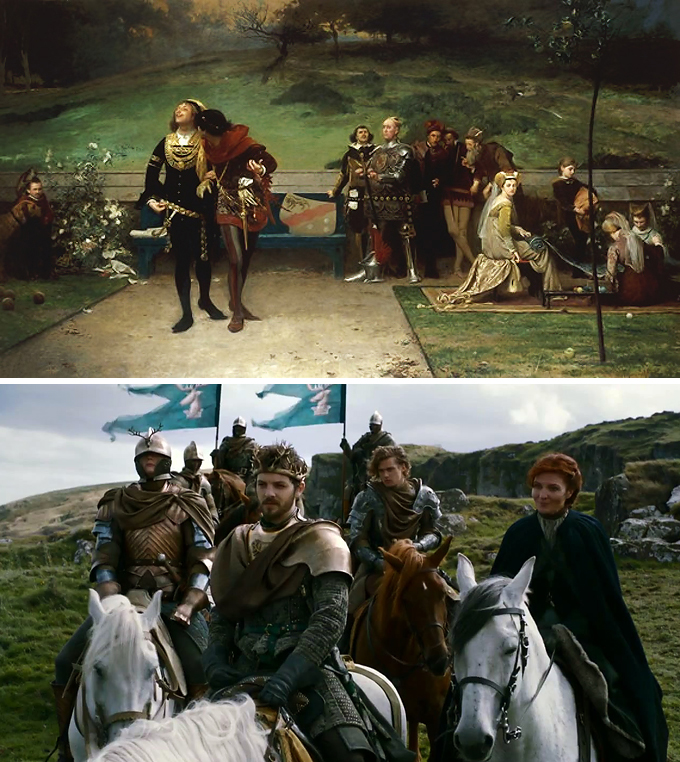
Eduardo II y su favorito, una pintura de Marcus Stone en 1872 (DP) y Gethin Anthony y Finn Jones como Renly y Loras (HBO / Canal +).
El primero, su famosa huida juntos de Newcastle cuando los Lancaster atacaron la ciudad en 1312, del mismo modo que los de la ficción huyeron juntos de Desembarco del Rey cuando los Lannister se hicieron definitivamente con el control de la corona. Y el segundo, los también recordados festejos en los que la estrecha relación de uno y otro se hicieron evidentes: el torneo de la Mano en Juego de Tronos y los que siguieron a la coronación de la esposa de Eduardo II en la realidad, en los que Gaveston apareció vestido con los colores reales y Eduardo soliviantó a la nobleza y a su nueva familia política no prestándole atención a la reina, sino a él. Entre otros detalles reveladores —como él éxito de Gaveston en las justas, similar al de Loras en la ficción— está el de que la fiesta se desarrolló en un enclave histórico, hoy un pequeño municipio inglés, cuyo nombre suena a cualquiera que lea o vea Juego de Tronos en su idioma original: Kings Langley. Martin no ha admitido ni desmentido la inspiración en ese famoso enclave para bautizar Desembarco del Rey —Kings Landing, en inglés—, pero he aquí una pista: el año pasado, la HBO trasladó al municipio un pequeño acto promocional en el que el pueblo cambió oficialmente su nombre durante una semana por el de la capital de los Siete Reinos.
Caprichos de un rey niño
¿Qué respondería si decimos que el perverso rey niño Joffrey Baratheon podría inspirarse de pasada en Alfonso XIII? Que estamos locos, seguramente, y buscándole los tres pies al gato. Hace poco el propio autor confesó que la sonada Boda Púrpura en la que murió se inspira «un poco» en el asesinato de Eustaquio IV de Blois, hijo —aunque adulto—de Esteban de Inglaterra, y en la Edad Media inglesa existieron varios reyes niños que podemos asimilar con Joffrey. El más célebre de todos, Enrique III, guarda los suficientes paralelismos con el personaje como para darnos por satisfechos. Gobernó en el siglo XIII, ascendió al trono con solo nueve años y lo hizo en el contexto de la primera guerra de los Barones, un enfrentamiento entre casas nobles en el que su padre murió de disentería. En los manuales de historia se suele reseñar su fuerte espiritualidad, su mal gobierno y su inclinación al derroche. Fue el abuelo de Eduardo II, por cierto, de quien hablábamos unas líneas más arriba.
Pero, ¿de dónde viene el rey niño caprichoso, sádico y cruel que ha movido nuestra inquina durante varios libros y más de tres temporadas televisivas? George R. R. Martin es estadounidense y en la historia de su país tiene mucha más presencia otro monarca niño, seguramente porque lo fue en la última gran guerra que Estados Unidos libró contra un reino europeo en la era colonial: la hispanoamericana de 1898. Aunque la regencia de España residía en su madre María Cristina y el gobierno del país en Práxedes Mateo Sagasta, el rey coronado desde el mismo día de su nacimiento era Alfonso XIII, una situación percibida con perplejidad en la política republicana al otro lado del Atlántico. La propaganda bélica se cebó con la figura del joven rey, retratado como un niño lastrado por numerosos males, entre ellos la «crueldad», el «antagonismo de la civilización», los «métodos del siglo XVI» y verse acompañado por una «aristocracia corrupta».
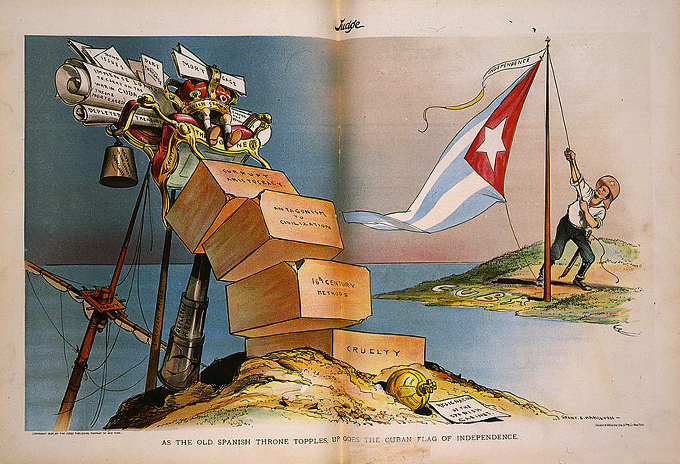
Y los paralelismos no acaban ahí. De hecho, empiezan con la propia vida de sus padres y la de los padres del joven rey de Westeros, Cersei Lannister y Robert Baratheon. Como hace el rey Robert en la ficción de Martin, el rey Alfonso XII era un mujeriego impenitente que se entregaba al adulterio de forma poco menos que indisimulada, hasta el punto de que dejó varios hijos bastardos, como Robert, y se suele considerar que la reina consorte vivió su muerte con alivio, como Cersei. Declarada María Cristina regente a su muerte como Cersei lo fue tras la de Robert, su mismo hijo Alfonso acabó heredando las inclinaciones poco puritanas del padre, como hizo Joffrey. Si el de la ficción acabó asaetando una mujer como parte de un juego sexual, Alfonso XIII tiene el honor de figurar en la historia de España no solo como uno de sus reyes, sino como el gran impulsor del género de la pornografía cinematográfica. Y un último paralelismo, aunque no en la figura del hijo sino del padre: como Joffrey, algunos sostienen que Alfonso XII tampoco era hijo del rey —Francisco de Asís, del que se dice con frecuencia que era homosexual— sino de la reina y su amante.
Todo queda en familia (I)
Con esto llegamos a ese punto tan oscuro de Juego de Tronos, el del incesto, y a la relación entre Cersei y Jaime Lannister, amantes y hermanos mellizos. Oscuro, al menos, si obviamos el punto de vista que exponía hace poco en una entrevista Nikolaj Coster-Waldau, que interpreta a Jaime: «Si te paras a pensarlo te das cuenta de que, en la serie, más o menos todas las relaciones lo son por motivos políticos, son matrimonios concertados. ¡Oh, no, espera! Hay una que se fundamenta en verdadero amor: la de Jaime y Cersei».
Antes que ellos los Targaryen, la familia real de los Siete Reinos, se casaron durante generaciones entre hermanos para mantener, en principio, la pureza de su sangre. Nos lo recordaba la propia reina Cersei en una escena emblemática de la primera temporada, aquella en la que se entrevistaba con Ned Stark para añadir que «cuando juegas el juego de tronos ganas o mueres; no hay término medio». A nadie se le escapa que, de haber ocurrido en la realidad, el ejemplo de la reina para justificar su conducta habrían sido los antiguos faraones egipcios, particularmente los de la dinastía ptolemaica.
Como los Targaryen, los Ptolomeos eran un linaje extranjero procedente del mundo clásico en la era de su decadencia —del heleno en la realidad, de la antigua Valyria en Juego de Tronos— que se hizo con el trono mediante la conquista; como los Targaryen, comenzaron después a casarse entre hermanos para mantener a la familia en el poder; y como los Targaryen, fueron finalmente desalojados del trono por sus antiguos socios políticos. Aunque en ambos casos la razón formal fue otra, la verdadera causa política es quizá la misma que Cersei anuncia aquella escena: «cuando juegas el juego de tronos ganas o mueres; no hay término medio». Los Ptolomeos y los Targaryen se casaban entre ellos. No jugaban al juego de tronos.
Todo queda en familia (II)
Esto, en lo que concierne a los Targaryen. Si la historia de Cersei y Jaime tiene un precedente claro, sin embargo, ese es el de Lucrecia y César Borgia, hijos de Alejandro VI a los que el exmarido de ella acusó de incesto. Como a la propia Cersei, también a Lucrecia su padre le concertó varios matrimonios de conveniencia para afianzar su poder territorial, primero con Milán mediante Giovanni Sforza, después con Salerno mediante el príncipe Alfonso de Aragón y con la antigua Ferrara mediante el matrimonio Alfonso d’Este. De nuevo no insistiremos en su historia, que está muy contada ya, pero sí señalaremos el paralelismo estructural de los últimos grandes Borgia con la historia de los Lannister de Juego de Tronos.
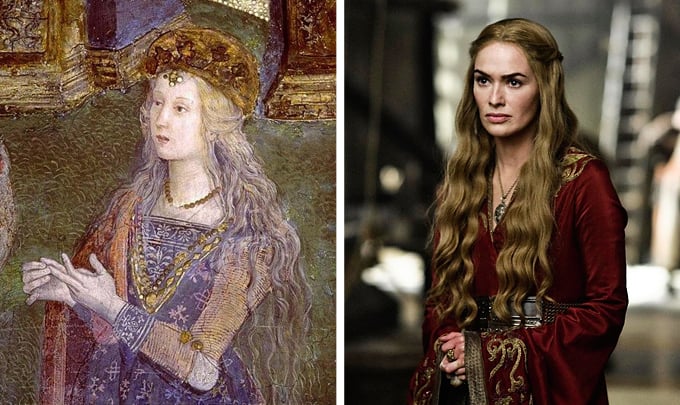
Lucrecia Borgia como Santa Catalina en un fresco de Pinturicchio de 1492 (DP) y Lena Headey como Cersei Lannister (HBO / Canal +).
Como Rodrigo Borgia al ascender al papado como Alejandro VI, Tywin Lannister se convierte en Mano del Rey gracias a la posición en la que sitúa a sus hijos; como los hijos de Alejandro VI, Lucrecia y César, también los de Tywin, Cersei y Jaime, son acusados de incesto y algunos les atribuyen un hijo juntos, Juan Borgia en la realidad, Joffrey en la ficción; y como le ocurre en la ficción con Tyrion Lannister, también ambos cuentan con un hermano pequeño, Jofré Borgia, rechazado y humillado por su padre —llegó a encerrarlo en el castillo de Sant’Angelo— que cuenta con la amistad de uno de sus hermanos, en la serie Jaime, en la realidad Lucrecia. Y si le hacen falta más detalles, le añadimos dos: todo esto fue durante las guerras italianas —que empezaron en el sur de Europa en 1494, solo diez años después del final de las de las Dos Rosas— y la coincidencia resiste la prueba del algodón —fonético—: pruebe a pronunciar en inglés «César» y «Cersei».
Una Severa en Desembarco del Rey
¿En qué lugar deja eso a los Tyrell de Altojardín y a su fulgurante matrona, la poderosa Olenna Tyrell, de soltera Redwyne? En uno complicado, pese a que parece el más sencillo de rastrear. Los Tyrrell —con dos erres— eran una poderosa familia inglesa en la época de las Dos Rosas cuyo miembro más recordado, James Tyrrell, sirvió a Ricardo III, el último York en el trono antes de la dinastía Tudor. Pero, ¿son los Tyrrell los Tyrell? No. Pese al nombre, los de Juego de Tronos tienen más que ver con la propia familia Tudor y, sobre todo, mantienen su paralelismo más evidente con un linaje de emperadores romanos: los Severos.
Particularmente cuando se trata de Olenna y de una de las más grandes matronas a la sombra que ha conocido la historia, Julia Maesa. Natural de Siria y solo una visitante ocasional en Roma —como Olenna es natural del sur y solo visita la capital—, fue cuñada, tía y abuela de cinco emperadores romanos, varios de los cuales consiguió ella misma entronar y destronar hasta conseguir que se dé por cierto que entre los Severos, ellos ocupaban los cargos y ellas —Julia Maesa, su hermana Julia Domma y sus hijas, Julia Mamea y Julia Soemia— eran quienes detentaban realmente el poder. Y es concretamente una historia, la del joven emperador Heliogábalo, la que revela los paralelismos más evidentes entre ambas estirpes nobles.
Como Julia Maesa fue abuela de Heliogábalo, un joven transexual —a veces considerado el primero del que se tiene noticia en la historia—, Olenna Redwyne tiene un nieto homosexual, Loras; como Julia Maesa sitúa a su nieto en el trono cuando es solo un adolescente, Olenna casa a su nieta con el rey adolescente de Juego de Tronos; como ocurrió con el emperador Heliogábalo, Joffrey se revela pronto como un monarca enajenado y su breve reinado está marcado por la crueldad y los escándalos sexuales; como Olenna hace con Joffrey, Julia Maesa encarga el asesinato de Heliogábalo y lo hace para que el trono recaiga en su hermano pequeño; como el hermano de Heliogábalo, Alejandro Severo, el joven Tommen Baratheon resulta ser un monarca más dócil y templado. Y todo esto ocurre en el marco de la imposición de una nueva religión monoteísta en Roma, la de El-Gabal, que pretende desterrar el politeísmo con el patrocinio de la propia familia real.
Ingredientes de una mala malísima
Religión, sí, porque no nos íbamos a ir sin hablar de Melisandre. Junto a Varys y Meñique, la sacerdotisa roja se integra en el reducido conjunto de personajes a los que no ata el parentesco con las familias nobles, y que por lo tanto resultan más complicados de rastrear. ¿Es Melisandre Ana Bolena, la mujer por la que Enrique VIII abandonó a Catalina de Aragón para que le diera heredero varón y de la que escuchó el mensaje reformista religioso? ¿Es acaso Rasputín, el enigmático monje y místico que consiguió embaucar a la familia Romanov, al que se acusó de controlar a la zarina y de llevar la desviación y la extravagancia sexual a la corte rusa? ¿O es Torquemada, el fraile que sembró su poder confesando a la reina Isabel la Católica, creador del Tribunal de la Inquisición e inquisidor general poco después de que la institución quemase vivas en Sevilla a sus primeras seis víctimas? Melisandre es todos y seguramente alguno más, como descubriremos conforme avance la historia de Juego de Tronos. En la historia de los reyes ha habido muchos favoritos y no pocos han conquistado la posición en el púlpito y la cama, cuando no en las dos a la vez.
Algo similar, pero al revés, ocurre con la figura de Ana Bolena, la Carmen San Diego de Juego de Tronos: todo el mundo la busca, todo el mundo da con pistas de su presencia y, sin embargo, nadie la acaba de encontrar. Aunque muchos la ven en Melisandre y en Cersei —quizá más por su marido Robert, en muchos aspectos una versión Enrique VIII, y porque también acabó siendo acusada de incesto—, lo cierto es que es Margaery Tyrell quien recuerda más a esta figura capital de la historia inglesa.

Ana Bolena c. 1533-1536 en un retrato anónimo (DP) y Natalie Dormer como Margaery Tyrell (HBO / Canal +).
Lo primero por lo más evidente, que es que la actriz que la interpreta, Natalie Dormer, dio vida a Bolena en la ficción de Showtime Los Tudor. Pero, sobre todo, por su papel en el triángulo que acabó componiendo junto al rey Joffrey y la que iba a ser su esposa por matrimonio de convenciencia, Sansa Stark, muy similar al de Bolena con Enrique VIII y su primera mujer, Catalina de Aragón. Como Ana Bolena, Margaery es una noble de menor alcurnia que Sansa, que juega en este supuesto el papel de Catalina de Aragón. Como Ana Bolena, Margaery hizo a su familia medrar y ganar influencia en la corte gracias a su relación con el rey. Como ella, Margaery implicó a su hermano en los asuntos cortesanos —Loras en la ficción, Jorge Bolena en la realidad— y sostuvo la amistad de Sansa, al igual que la original hizo con Catalina. Y, por supuesto, Margaery acabó desplazando a Sansa para casarse con el rey, como Ana Bolena hizo con la hija de los Reyes Católicos. Si los paralelismos no resultasen convicentes, anótese al menos la pijada: Catalina de Aragón era tataranieta de Juan de Gante y emparentaba lejanamente con los York.
Y hasta aquí el repaso, con tres casos de incesto real, tres reyes homosexuales y al menos dos matanzas reales. Y esto dejándonos en el tintero a los Príncipes de la Torre, a los Greyjoy y la revisión de lo que ocurre en Dorne, que también tiene tela. Lo decíamos al principio y al final creemos estar en posición de poder repetirlo: si Juego de Tronos peca de exagerada no lo hace con el culebrón, sino con el asunto de los dragones y el de los señores esos tan blancos y malhumorados que aparecen de vez cuando. La realidad, y para muestra un botón, supera ampliamente a la ficción.
Actor Bob Hoskins dead at 71

Actor Bob Hoskins, known for roles in “Who Framed Roger Rabbit?,” “Hook,” “Brazil,” “Super Mario Bros.” and “Nixon,” died on Tuesday evening due to complications from pneumonia, his agent told the press. He was 71 years old.
Hoskins, nominated for a Best Actor Oscar in 1987 for his role in “Mona Lisa,” retired from acting in 2012 after being diagnosed with Parkinson’s in the fall of 2011. “Bob died peacefully at hospital last night surrounded by family, following a bout of pneumonia,” according to a family statement. “We ask that you respect our privacy during this time and thank you for your messages of love and support.”
Hoskins’s last moments were spent surrounded by wife Linda and children Alex, Sarah, Rosa and Jack at a hospital. He was born and raised in West Suffolk.
Instagram asked Rihanna to stop posting nudes

On Tuesday, Rihanna posted pictures from her Lui Magazine photoshoot to her Instagram account. Most of the photos involved her being topless. Inside of an hour, Instagram took the pictures down, which Rihanna felt was unfair. So she posted this in retaliation.
A source from Instagram told TMZ that they sent her an email warning her to keep her clothes on or risk being banned. I assume they have this rule for everybody? Twitter, however, was fine with the pics. So if you want to see them you can see them here (NSFW).
The Doritos origin story: Repurposed garbage from Disneyland

Doritos (love the “#bold” hashtag applied non-ironically to people who regularly eat Doritos) are a ridiculous product just taken at face value. But when you learn that they were born in a Disneyland dumpster, they become an absurdist allegory of the American consumer condition.
Shortly after Disneyland opened in 1955, the founder of Frito-Lay got permission from Walt Disney to open a restaurant in Frontierland with a Mexican-ish theme. “Casa de Fritos” was, unsurprisingly, all about the Fritos. Customers got free Fritos, and Fritos were incorporated into many of the dishes. Fritos were dispensed by an animatronic vending machine that featured the terrifying “Frito Kid” asking his assistant “Klondike” to bring the bag up from a mineshaft. I guess the conceit is that Fritos were mined by Forty-Niners?
Casa de Fritos contracted their tortilla production to a company called Alex Foods. One of the salesmen from Alex Foods, making a delivery to Casa de Fritos, noticed stale tortillas in the garbage and gave the cook a little tip: fry them and sell them as chips instead of throwing them away. Casa de Fritos began making these fried, seasoned chips to enormous success, but didn’t report this new menu item to the Frito-Lay company.
A year later, the new VP of Frito-Lay, Archibald Clark West, dropped by the restaurant without warning and saw hundreds of jaws dancing to the sweet crunchy symphony of profit potential. “This shit is gold!” he (probably never) said, christened them “Doritos,” and made a deal with Alex Foods to produce them as a snack. When Doritos started to get big, production of the chips was moved to a bigger factory in Tulsa, effectively edging Alex Foods off the billion-dollar train. Thankfully, the Morales family, who own Alex Foods, weren’t ruined by the loss.
Equally uplifting is West’s sincere enthusiasm for the Dorito. Throughout his life, he remained committed to the snack, even serving as a taste tester after he retired from the vice presidency. His favorite was plain corn, although he conceded a liking for Cool Ranch as well. Shortly before he died, he tasted a Cheeseburger flavored Dorito and spat it out. At his funeral, his daughter threw Doritos into the grave after him, as per his request.
So next time you pick up a bag of Cool Buffalo Maelstrom or Fucking Natural Cheese Disaster Doritos, recall that they were once literally the garbage of Disneyland, and reflect on the poetry of modern life.
The nesting doll effect is kind of like that shopped picture of Kanye West taking taking a picture of Kim taking a selfie with their baby with her iPhone on his iPad.
H/t: OC Weekly Pepsico | Today I Found Out
The VICE Guide to Pizza

Illustration by Nick Gazin
After originating in the Mediterranean in the 1800s, the round pie we call pizza became a global sensation post–World War II. Just about every nation in the world has its version of this versatile dish. The genius of pizza is that it's infinitely adaptable. Everyone has his preferences and unique predilections. Cultures put their own spin on pizza, but it's all equal... or is it?
A restaurant in Canada created the world's most expensive pizza just this month. For $450, you can get a white truffle pie with lobster thermidor, black Alaskan cod, smoked salmon, tiger prawns, and Russian Osetra caviar. It probably tastes like licking the crotch of a track suit after a marathon, but the Dr. Frankensteins who invented this monstrosity are able to call their dish "pizza" because their stupid ingredients are on a round disc made of dough. I refuse to stand for that.
It's time that we as a society put our foot down and set some guidelines for what is and isn't pizza. We've assembled an A-Z list of the most important aspects of pizza culture and SPOILER ALERT: none of them include fucking caviar.
AFTER SCHOOL
This is the witching hour when it comes to pizza. While pizza definitely has its moments at dinner and during the wee hours of the morning when you're plastered, it really shines due to its ubiquitous presence at after-school extracurricular activities. Whether it's post-soccer game or during a study session for final exams, pizza absolutely dominates this time slot. We haven't seen numbers like this since Cheers in its heyday. In fact, if it weren't for pizza at practice, mathletes all across the nation would starve to death.
Honorable Mentions: Anchovies, all-you-can-eat lunch buffet, artichokes, anal leakage
BIGFOOT
Whoever says Bigfoot isn’t real doesn’t remember Pizza Hut’s contribution to the world of cryptozoology. In the 90s, Pizza Hut introduced the "Bigfoot.” This gargantuan pizza was one foot wide and two feet long. Initially popular, it was quickly discontinued. Though there are some who say the beast is still out there…
The giant, square pizza was something of a mini-trend in the 90s. Domino's had the Dominator, which didn't last long. Even Little Caesars had one called "Big! Big!" This was also discontinued, and not just because of the stunning lack of creativity in the pizza's name.
Honorable Mentions: BBQ chicken, Book-It, breadsticks

Photo via Flickr user Peter
COLD PIZZA
Like revenge, pizza is a dish best served cold. Eating your pizza cold not only tastes great but is fast and easy. Sure the crust isn't as snappy, and the pepperoni now has the consistancy of an unused condom, but the congealed cheese is the secret weapon of the leftover slice. The magic of cold pizza cheese is not something I even want to understand. Telling me why it's good is like telling me how babies are made. WHO CARES, DUDE? I just wish there was a stork that delivered cold pizza to my house.
Honorable Mentions: CiCi's Pizza, crust first, coupons, CPK
DAD WEEKEND
Your parents sit you down and tell you that they still love each other. It isn't your fault, but they're going to start spending time apart. You know what that means? Twice a month you're going to get to order whatever toppings you want! Thank God your dad can't cook for shit. True love is a lie, and you're reaping all the benefits. Hey, maybe if your family spent more time eating a nice home-cooked meal around the table instead of inhaling pizza in front of the TV, you wouldn't be in this position in the first place. Ah, it's a vicious cycle. A delicious, vicious cycle.
Honorable Mentions: Deep dish, dessert pizza, delivery, DiGiorno
EAT PIZZA ANYTIME (YOU CAN)
Like a vaguely Jewish lightning bolt from the sky, Bagel Bites struck fast and hard on the cultural landscape in the 1980s and 90s. From its oppressively catchy jingle to its ability to be bought in bulk and served to snotty children (or snotty drunks), everything about the frozen pizza bagel was carefully crafted to immediately carve out a hole in my heart. Pop them in the oven for a few minutes and you have a bunch of tiny pizzas that can fit in the palm of your hand. In the morning, in the evening, and even at supper time. When pizza's on a bagel, you truly can eat pizza any time.
Honorable Mentions: Ellen DeGeneres's Oscars pizza stunt, Edgar (the delivery guy from the Ellen pizza stunt)

FROZEN PIZZA
Picture yourself alone, adrift in a godless universe on a dark Wednesday night in America's Middle West. You just got off an eight-hour shift at the liquor store. You come home to an empty, cold apartment filled with drained energy drink cans and fast-food wrappers. You open the freezer. There, under the fluorescent light, you see it: your dinner. The consistency of it is not unlike the box it sits in. The taste? If not for the hot sauce you poured on it after 20 minutes in the oven at 375 degrees, flavorless. It's not delivery. It's depression.
Honorable Mentions: Flatizza, folding your slice
GLUTEN-FREE
Bread is filled with gluten. Pizza is filled with fucking bread. So no, poindexter, you can't have gluten-free pizza. Or at least you shouldn't be able to. The proliferation of Celiac disease, however, has made money-hungry eateries of all shapes and sizes eager to cater to gluten-free geeks. Which is why, in spite of it all, you can now get gluten-free pizza. By virtue of the fact that the 17-year-old preparing it could give less than a fuck about your "condition," though, the restaurant warns that "Customers with gluten sensitivities should exercise judgment in consuming this pizza."
Honorable Mentions: Gout, Gangnam Style pizza
HERMAN CAIN
The Godfather himself. This guy sold pizzas and thought that would be enough to make him president. Looking back, I’m actually surprised America didn’t go for that. However, in an apparent nod to the Italians who pioneered pizza before him, his sexual aggression with female employees got the best of him and tanked his campaign. And to think, we could have had our first "pizza president." Perhaps history will right itself in the next election cycle, and we can all finally vote for the "Noid."
Honorable Mentions: Hungry Howie's

Photo via Flickr user Rolando Tanglao
ITALIANS
I’d like to start this off by thanking the Italians for inventing this fantastic dish. You were the first to put a bunch of cheese and random shit on a round disk made of dough. Pretty clever. We'll take it from here, though. Your crust isn't stuffed. Your pies are neither "hot" nor "ready" when I order them. Why is your sauce sweet? Where's all the cheese? I see zero cartoon mascots in your country. Do you even have an electronic system that allows me to track my pizza as it's being made? Oh, you don't? SMDH, Italy. Here in America, we're always "Makin' It Great."
Honorable Mentions: Internet pizza memes

Photo via Flickr user Cassidy
JUST GET SOME FUCKING BREADSTICKS, OK?
Pizza's overly eager little brother. Whereas the calzone is like pizza's obnoxious, arrogant cousin from the big city (a meal unto itself, basically a pizza folded into itself), breadsticks are a trifling but delicious complement to any meal. If you want to really lose your mind, usually there is a type of "insane" or "loco" or "crazy" bread that is just a bunch of breadsticks covered in melted cheese.
Wondering if anyone else wants breadsticks? Guess what? They do. Everyone secretly loves breadsticks. There are no Tumblr pages or novelty T-shirts dedicated to breadsticks, but that's because they're the Batman of comfort food. They're our silent guardian, our watchful protector, lurking in the shadows—the Carb Knight.
Honorable Mentions: The Jonas Brothers' hit song, "Pizza Girl"

KALE
Kale is a "superfood." Pizza is a "super" food, to be sure, but its health benefits are nonexistent. That's why, when you combine the two, not only do you negate the healthfulness of the kale, you ruin the taste of the pizza. What the fuck is wrong with you? Don't you know there are kids in Africa right now dying for access to superfoods?
Honorable Mentions: K! Pizzacone

LIQUID DEATH (A.K.A. "GREASE")
A two-ply napkin, applied to the surface of a grease-laden slice of pizza, is but an impotent attempt to protect the eater from the colon-crushing, waist-expanding nightmare that is said pizza. Emphasis, of course, on impotent. You can blot all you want, baby girl, but it ain't gonna do a goddamn thing, other than needlessly destroy a dozen napkins. If you're worried about the caloric content of your meal, here's a suggestion: eat something that isn't pizza. Or just throw up afterwards. The grease will coat your throat.
Honorable Mentions: Lactose intolerance, Lunchables pizza

Photo via Flickr user yoppy
MAKE IT YOURSELF (OR NOT)
There are many things you can make at home, and I am sure they're great: hamburgers, pasta, sandwiches, etc. It’s not that hard to make this shit on your own. Pizza, however, you can never do. I know you think you can, but unless you have a wood-fired oven and the ability to get that dough into a perfect circle, your DIY pizza is a sham. I learned a long time ago to give up on making my own pie. Every time it came out of the oven it looked like pizza's "before" picture in a plastic surgery ad. The slices end up being rectangular, the bread is too thick, and the cheese is never right. The above photo is ostensibly of a pizza, but throwing lunch meat on a round cracker does not a pizza make.
Honorable Mentions: Mozzarella sticks, marinara, Macaulay Culkin's pizza-themed Velvet Underground cover band

Photo via Flickr user Michael Gray
NEW YORK STYLE
The age-old debate: New York vs. Chicago. Chicago style is great. Really. It's delicious and filling. It's a truly special treat. It's also not as good as New York style. I mean, seriously. Look at this shit.
Why does this even need to be said? God bless you, Chicago. Your "pizza" is fantastic, but it's not pizza. Consolation prize for not being Los Angeles and putting avocado on your pies, though. Thanks for that.
Honorable Mentions: Napoli, Noid
OBAMACARE
"Papa" John Schnatter announced that implementing Obamacare at his Papa John's franchises would cause as much as a 14-cent increase in price and lead to employees' hours being cut. Heaven forbid a CEO who churns out one of the unhealthiest foods on the planet dole out a little extra cash to take care of his own. So next time you want a pizza, think about where your money is really going. (Your gut.) In fact, if the typical American family abstained from buying pizza and saved that money instead, then a lot more people in this country would be able to afford health insurance.
Honorable Mentions: Oregano, obesity
PINEAPPLE (PROS & CONS)
PRO: Warm, juicy, flavorful, a bit sweet and a bit sour, pineapple is a topping that ought to go without saying for true pizza aficionados. Also, pineapple allegedly makes your cum taste better. I don’t know if that’s true or not, but there’s no way pineapple is making your cum taste worse. If it makes you feel better, let’s also just say that it’s locally grown and organic. There you go. Now just put it on your pizza and enjoy yourself.
CON: This is pizza, not fruit salad. Next thing, you're going to tell me I should put grapes and cantelope on pizza. This is the slipperiest slope there is. When it comes to pizza, I am a strict constructionist.
Honorable Mentions: Pizza saver, "Pizza por Pesos"
QUICK DELIVERY TIME
Unless you're a mom or a nerd, pizza is not a pre-planned affair. Therefore, the quickness of delivery time is almost more imperative to your enjoyment of pizza than whether the damn thing is even edible. We all know at least one person who's eaten an uncooked frozen pizza because they needed it now.
In fact, the hierarchy of pizza qualities, in order from most to least important, is as follows:
1. Actively not made of poison
2. How fast it gets to your mouth
3. Quality of ingredients
4. Does the money you spend on this pizza go to scumbag anti-abortion groups?
5. GMOs or whatever
6. Did it fall on the floor cheese-side-down?
7. Did it fall on the floor cheese-side-up? (This is totally fine and actually improves the pizza, because you are eating a miracle.)
Honorable Mentions: Queen Latifah did a voice-over for a Pizza Hut commercial
RANCH
In March of this year, a pizza place in Dallas, Texas, charged patrons $1,000 for a side of ranch in order to discourage the use of the creamy dressing on their Neapolitan-style pie. Jay Jerrier, owner of Cane Rosso, claimed that he was merely joking when he slapped the insane figure on a bottle of ranch hanging from the wall of his establishment. This "joke" quickly turned into a 900-comment-long Reddit flame war. Opinions ranged from "He's in the high quality end of the service industry, you're not paying for food, you're paying for his expertise. He has every right to point out that ranch should not be requested or used in his own establishment" all the way to clever pop culture references like "No soup for you!" Remember? Like in that sitcom your dad used to watch.
The truth is, ranch is delicious. Pizza crust is usually dry, dull, and flavorless. Why not dunk that shit in some creamy salad dressing? What are you, some kinda commie?
Honorable Mentions: Rock-afire Explosion
STUFFED CRUST
Let's all drop down on bended knee and kiss the ring of Pizza Hut founder John R. Pizzahut, who, in his infinite wisdom, saw fit to go in through the out door and stick it where it doesn't belong. "It," of course, is cheese, and "where it doesn't belong" is inside crust. What now seems like an obvious move was highly controversial at launch. Who had ever dreamed of eating pizza backward? Now, it's accepted practice. Not one to rest on its past success, Pizza Hut has stepped up its game again and created the 3-Cheese Stuffed Crust Pizza.
It took a true visionary to buck convention and begin the golden age of pizza we currently enjoy. Thank you, John R. Pizzahut. Your legacy will live on forever. Jackpot!
Honorable Mentions: Square pizza, salad pizza
TEENAGE MUTANT NINJA TURTLES
I’m not saying the Ninja Turtles made pizza what it is, but the early 90s were a great time for pizza all around and the Turtles benefit from that association. Leonardo, Donatello, Michelangelo, and Rapahel showed the ideal dream life we aspired to but could never have: they hung with their bros all day, they used weapons, and they ate pizza all the time without any of the bodily consequences of being human. They could never get flabby stomachs, and their big, weird green muscles seemingly were never affected either. They also had a great loft-style sewer apartment that any slum-chic trust-funder would kill for. The Turtles were grotesque abominations of nature, just like we all are, but they had one another, and they had pizza.
Honorable Mentions: Tummy (where the pizza goes)
UNDERGROUND PIZZA JOINTS (SUCK)
I know you think that pizza place in the basement of some guy's house in a dark alley 20 miles outside of town has to be the greatest pizza in the world, but chances are, it's crap. Unlike “secret” burrito and taco spots, secret pizza spots don't really exist. If it's good pizza, people know about it. Hate to burst your bubble, but just stuff some Sbarro in your mouth and deal with the crushing reality that is delicious corporate pizza.
Honorable Mentions: "U Bake" pizza
VARIATIONS
Call me xenophobic if you must, but I hate when "worlds collide." Fusion, be it jazz or Japanese, maddens me. Which is why I'm confused and angered by any variation on the pizza's classic cheese, crust, and toppings formula. While burgers are great, and pizza is fantastic, the two should stay on their own ends of the culinary Mason-Dixon Line.
A Korean chain called Mr. Pizza down the street from me called sells seafood-covered pizzas with crusts made out of "sweet potato mousse"; said pizzas are served with orange marmalade dipping sauce and cost $30. This is not pizza. This is the subject of a listical describing how "weird" Asian culture is.
Honorable Mentions: Vegan pizza
WEIRD TOPPINGS
There's a whole litany of ingredients that can go on a pizza, and at this point we've become bored with the same old cheese, pepperoni, and mushroom variations we've had for years. Anchovies are the standard weird topping, although some people swear by them. Jalapeños have made it into the rotation lately. My friend Dave loves to order jalapeños on his pizza. I try to avoid eating pizza with Dave. Isn't that a shame? A friendship torn asunder due to pizza? Pizza is supposed to bring us all together! While we all have our predilections, I would suggest sticking to the mainstays in larger groups. It's just gonna go down easier that way. But when you're alone, or with a trusted friend? Get weird, bro. Let that freak flag fly. Anchovies, jalapeños, and all.
Honorable Mentions: Wings (buffalo), white pizza

X-TRA LARGE
At Costco, you can purchase an 18'' pie for $9.99. That's an amazing price, and an exciting proposition. Yet no one you see purchasing one looks excited. It's almost as if their lives are hell.
Honorable Mentions: X-Files episode with pizza in it. Remember that one?
YOU BETTER TIP THE DELIVERY GUY
Only pornography has recognized that pizza delivery is a profession worth blowing. Women love men in uniform, which is one reason the pizza delivery guy was the top porn character of the 80s and 90s. Society as a whole, though, has been slow to recognize the importance of the job. Pizza delivery is a profession that deserves respect regardless of the position’s pay, like a soldier or mail carrier, and a new uniform would go a long way toward that end. I would suggest something sleek, black, and militaristic, with a hat that has room for the restaurant’s logo on the front. Maybe an arm band? How about leather boots? I think we're onto something.
Honorable Mentions: Yelp reviews, Yolo pizza
ZITS
What grease goes in, it must come out, no matter how delicious it may have been going down. Zits are a nice taste of irony, too, since they make your face look like exactly what you just ate. Although they’re ugly and annoying, zits provide a helpful service: They protect us from ourselves. Without zits and fat, there would really be no reason not to eat pizza for every meal.
Honorable Mentions: 'Za (don't call it that)
Follow Dave, Alison, Allen, Grant, Josh, and Megan on Twitter.
The New Wave of Foodies Is Dumber Than Ever
Abkhazia Is Yet Another Country That Doesn't Exist

Sukhumi, Abkhazia, 2013. Only a few people have access to the military parade and get the chance to see the event up close.
In the fall of 2013, I traveled to the Republic of Abkhazia to experience firsthand the festivities surrounding the 20th anniversary of the its victory against the Georgian army—the event that gave birth to the country in its current form. Abkhazia is a ghost nation; it is not recognized by the international community, and it officially still belongs to the country of Georgia. To get there, I had to travel through Georgia and three different border crossings. Needless to say, the two places are not on the best terms.
Almost completely cut off from the outside world, Abkhazia is still suffering from a war that’s very much alive in people's minds. Located to the southeast of Sochi, the Caucasus republic is wedged between southern Russia, Georgia, and the Black Sea. Its economy is sluggish, but that doesn't defeat the people's spirits.
I stayed in Abkhazia for two weeks, and what I enjoyed the most was the constant mix of modernity and traditions: ancient religious devotions and flat-screen computers, young girls jumping around carelessly during a memorial for soldiers who died for independence—that kind of thing.

Dranda, Abkhazia, 2013. Maya is posing with the Abkhazian flag. Maya and her family are Syrian refugees. Nine people live in a renovated three bedroom flat provided by the Abkhazian state. They all love Abkhazia and want to build their lives there.
A few weeks after its self-proclaimed independence at the end of the Soviet rule, on August 14, 1992, Abkhazia was invaded by Georgian tanks. A year later, on September 30, 1993, Tbilisi’s troops were defeated by the Abkhazian armed forces with the help of volunteers from North Caucasus. Several thousand were killed, and nearly the entire Georgian-speaking population fled the republic.
But that military victory over Georgia was only the beginning of a long ordeal. Despite formally declaring its independence in 1999, Abkhazia has been under an economic embargo by the international community for nearly 15 years. It was only after the 2008 war between Russia and Georgia that a weak light was seen at the end of the tunnel for Abkhazians, when the republic's legitimacy was recognized by Russia. Almost everybody won. Abkhazians got their houses gradually rebuilt (most were destroyed during the Patriotic War of 1992 and 1993), and Russia moved one step further into Georgia proper. Today, the security of the self-proclaimed republic is manned by the Abkhazian military and a Russian military base.

Sukhumi, Abkhazia, 2013. A large military parade involving several hundred soldiers, dozens of tanks and helicopters, was held on Independence Day on September 30
Abkhazia is gradually emerging from its autarky, but it still has a long way to go. Other than the diplomatic support of Vladimir Putin, the only places they have secured recognition from are Venezuela, Nicaragua, and the Pacific islands of Vanuatu and Nauru. Cargo from Turkey is detained by the Georgian navy, and the only one able to keep the country afloat is its Russian big brother.
I discovered Caucasus in 2012, while reporting on the Chechen minority in the Pankisi valley, in northeastern Georgia. I did a little reseach, but back then the only feedback I got about Abkhazia was negative. People would tell me it would be impossible and dangerous to go there. But everyone I spoke to was Georgian, so I decided to see for myself.
My goal was to show the state of Abkhazia today, beyond clichés. It's been 20 years since the war of independence and five years since the Russian-Georgian war.
I had the amazing opportunity to attend the independence-commemoration festivities of September 2013. Not wanting to stick to the official program, however, I relied heavily on my local contacts and explored the country from within. I visited their businesses, art galleries, monasteries, schools, and ministries.

Sukhum, Abkhazia, 2013. During the festivities, Abkhaz young girls are waiting to go on stage in their traditional clothes.
I was struck by how easily people gave me access to their institutions—including the Ministry of the Interior. It was obvious that this was a country in expectation, eager for a nod of approval from the outside world, and was therefore trying to show itself in the best light.
As for what the future holds, the normalization of relations between Georgia and Abkhazia seems to still be a challenge. As my photographs show, the memory of the 1992–1993 war is still alive in the minds of Abkhazians and Georgians. In fact, Abkhazians consider any reunification with Georgia a potential threat to their national identity.
Yet the future of their relations with Russia is even more difficult to predict. Abkhazia is becoming more and more dependent on Putin, both in terms of security but also financially: Its currency is based on the Russian ruble, and 70 percent of its economy depends on Russian subsidies. Abkhazia wants to preserve its independence at any price, but I'm not that sure it can afford it.
Guillaume Poli is a French photojournalist. He worked for Paris Match, Le Parisien,Télérama, and L’Humanité. His full report on Abkhazia is available on Epic Stories here and here.
CLICK THROUGH FOR MORE OF GUILLAUME POLΙ'S PHOTOGRAPHS

Sukhumi, Abkhazia, 2013. The pupils from Pushkin Secondary School are about to commemorate the 20th anniversary of independence and victory over Georgia. As I had nothing special planned, I went to this school in the city center, as the children were preparing a concert. At the entrance, I presented my certification and was allowed to enter. Once inside, I renewed the operation and started taking pictures. An angry-looking man asked me what I was doing. When I showed him my certification, he didn’t pay attention to it and asked me to follow him. After several phone calls (perhaps to the ministry), he finally allowed me to photograph the school celebrations.

New Athos, Abkhazia, 2013. Father David (on the left) is trying to instill a monastic life in this small Orthodox community, which fears of becoming a mere touristic monastery. We are in the room where Father David and his disciples eat after the late afternoon mass. A liturgical reading closed the meal that I shared with them in a calm and caring atmosphere. The faithful do not live in the monastery; Father David has built a community of faithful disciples who come every day.

New Athos, Abkhazia, 2013. This Orthodox monastery was built by Russian monks in the 19th century on the supposed site where martyr Saint Andrew lived. Each year, the monastery attracts nearly a million tourists and pilgrims who pass through Sochi to visit Abkhazia.

Sukhumi, Abkhazia, 2013. On Friday nights, young Soukhoumians come to dance in this Soviet-style café adjacent to the Black Sea. It offers a large dance floor open to the beach.

Sukhumi, Abkhazia, 2013. During the 20th anniversary of the military victory over Georgia, a dense crowd is watching the parade of the Abkhaz army. Here, children grow up faster than they do elsewhere. They have not known the 1992 war but live in an area of tension and conflict.

Sukhumi, Abkhazia, 2013. During the week of September 30, many festivities, concerts, and dances in traditional costumes are held.

Sukhumi, Abkhazia, 2013. These veterans of the 1992–1993 war are received by President Alexander Ankvab in the Chamber of Deputies.

Sukhum, Abkhazia, 2013. In Pushkin Secondary School, I attended the rehearsals before the September 30 commemoration.
Using a Foreign Language Affects Your Ethical Reasoning

(Photo: Elliott Brown)
You're standing on a footbridge overlooking a train track. A train is coming down that track. It is about to hit and kill five people.
A very heavy man is also on the bridge. If you push him off the bridge, his body will stop the train, but it will also kill him.
Would you push him?
How you answer this ethical dilemma may be affected by the language in which you hear it. Researchers at the University of Chicago and Pompeu Fabra University in Barcelona found that when people encountered this dilemma in a foriegn language, they were more likely to take the utilitarian option: pushing the man off the footbridge. Science 2.0 reports:
The researchers collected data from people in the U.S., Spain, Korea, France and Israel. Across all populations, more participants selected the utilitarian choice — to save five by killing one — when the dilemmas were presented in the foreign language than when they did the problem in their native tongue.
Even with randomizing the participants' language groups, "those using a foreign language were twice as likely to respond with the utilitarian approach that is more in the service of the common good of saving more people," said lead author Albert Costa from the Center of Brain and Cognition, Universitat Pompeu Fabra, Barcelona. Costa is currently a visiting professor at the University of Chicago.
-via Marilyn Terrell
POLL: Would you push him?
- Yes.
- No.
- Just show me the answers!
Map: Who Wants to Move Out of State Right Now?
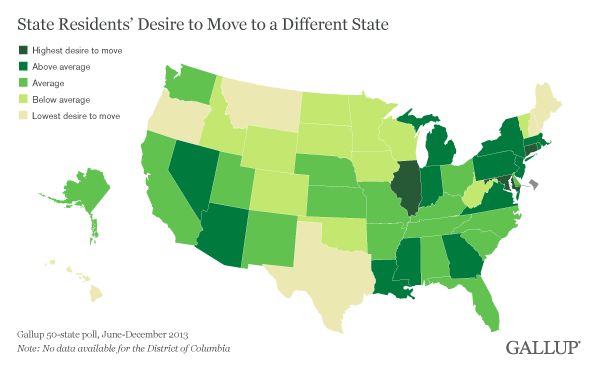
If you live in Oregon, Maine, New Hampshire, Montana, Hawaii, or (naturally) Texas, it's not likely that you want to move out of state. But if you live in Illinois, Maryland, or Connecticut, there's a good chance that you're trying to escape.

From June to December of last year, Gallup asked at least 600 people in each state, "Regardless of whether you will move, if you had the opportunity, would you like to move to another state, or would you rather remain in your current state?"
After compiling responses, Gallup created the map and charts that you see above. The dark green areas indicate a more intense desire to relocate out of state. Fully 50% of respondents in Illinois wanted out.
-via Popular Science
'The Onion' to Parody Buzzfeed and Upworthy with New Site Clickhole.com
 Buzzfeed and Upworthy are about to be the butt of a bunch of gags by The Onion. According to an announcement made by Onion News Network host Jim Haggerty (played by Brad Holbrook) at New York's digital content NewFront presentations yesterday, the site is planning to launch Clickhole.com in June, which will put "content and sponsored posts side by side, with barely any distinction between them." Some items that will be featured on Clickhole.com will include, per the New York Business Journal:
Buzzfeed and Upworthy are about to be the butt of a bunch of gags by The Onion. According to an announcement made by Onion News Network host Jim Haggerty (played by Brad Holbrook) at New York's digital content NewFront presentations yesterday, the site is planning to launch Clickhole.com in June, which will put "content and sponsored posts side by side, with barely any distinction between them." Some items that will be featured on Clickhole.com will include, per the New York Business Journal:
- Quizzes like "Which pizza should I have for dinner tonight? (presented by Pizza Hut)"
- Uplifting personal tales in list forms: "Seven pricks that defied the odds and didn't go into finance."
- The aww factor: A video titled "What this adorable little girl says will melt your heart." (It's actually a cogent explanation of how brands monetize adorable little kids, as spoken by an adorable little kid.)
- And finally, photo slide shows with no words: "Six kinds of hay."
The Onion didn't shy away from digs at advertisers during yesterday's presentation, which was aimed at online branded content. One of the quotes featured in their videos: "Nelson Mandela, as he lay on his death bed said, 'My greatest regret is that I never generated buzz, and expanded my brand's reach through a cross-promotional digital partnership with a major lifestyle brand with strong appeal among Millennials such as Pringles, or Old Navy. I have wasted my life.'"
0 CommentsBitchcraft (1997) Olivier Jansen
At its intended last gig (at a biker festival),the decision to incorporate the orgiastic, pagan sex from its home life into the stage act gave birth to Rockbitch. The band toured Germany, France, Switzerland, The Netherlands, Sweden, Denmark, the UK, (but were banned in Scotland) , Italy, Spain, Slovenia and Estonia and did a promotional tour that involved Canada (but were eventually also banned without having played) , while instituting its new theme of liberation through sexual freedom.
Rockbitch became infamous not only for performing live sex acts, but also doing so with audience members via "The Golden Condom". At a point during its show, a condom was tossed to the crowd and whomever caught it (male or female) was taken backstage for sexual relations with one or more band members. This led to critics saying they tried to sell bad music through sex; however, fellow musicians from disciplines as varied as jazz (bassist Jonas Hellborg) and funk/rock (Flea from the Red Hot Chili Peppers) have voiced their appreciation.
Rockbitch toured widely from approximately 1998 until 2002, meeting increasing resistance from authorities, particularly English town councils who often banned its concerts. Many of the Rockbitch crowds consisted of drunken lads seeking nudity, not typially interested in any "message"; however, Rockbitch also attracted followers that seemingly understood the band's message and they consisted mainly of women.
It was local authorities, not the public itself, who caused a struggle. Babe stated in the program "Anna in Wonderland" : "Rockbitch had no problem with lads out for seeing breasts, as they were a component of the audience, there were always others seeing the deeper meaning and both groups had a good time. They generally made up for a great combined atmosphere".
Outside the UK (and censorship problems it also encountered in some states of Germany) March 2008 audiences were sympathetic, particularly in Holland, where they drew vast crowds of men and women from all walks of life.
The Rockbitch lineup became entirely female . Original lead guitarist The Beast retired, taking over management/production. Babe moved into lead guitar duties (from rhythm) while Luci, previously a "Stage Slut" (one of the nude dancers and sexual band/crowd liaisons) instead strapped on a rhythm guitar.
Members lent their voices to female and sexual issues, were sponsors of the Sex Maniacs Ball (now Night of the Senses) founded by Tuppy Owens, openly voiced their admiration for sexual politics icons such as Annie Sprinkle and Betty Dodson, and generally put in a good word for open female sexuality as a healthy part of human nature. Via the Rockbitch website, on which members could also view their community life, the band had contact with straight/bi/lesbian women reaching as far as Borneo, Chile, Japan, India and the US, all of whom expressed a sense of empowerment and justification by the stated beliefs of Rockbitch.After the release of its first studio album, "Motor Driven Bimbo", which received critical acclaim in many countries (OOR Magazine in The Netherlands, the UK, and Japan), Rockbitch was dropped by its record company for refusing to remove sex and nudity from its stage act. A second, goth-influenced album called "Psychic Attack", which featured the song "I Wish I Were" written by American poetess Erzsebet Beck, was never released. Following continued pressure about its sexually driven themes and performances, Rockbitch ceased performing in 2002 and was the subject of a 30-minute documentary on BBC Choice the same year [Anna in Wonderland ] and an hour-long documentary broadcast on Channel 5 in the UK in 2003. [This is Rockbitch] In 2005, the entire latter-day Rockbitch lineup emerged under the name MT-TV. This was a music-only project—no sex or nudity of the Rockbitch days—but it incorporated stage theatrics. After a UK tour in summer 2005, they performed throughout the United States.
Louis C.K. Went on a Twitter Rant About His Kids' Homework
 Louis C.K. took to Twitter yesterday to express his frustrations with the homework his elementary school-aged daughter is being assigned by a New York public school to prep for standardized testing. In a series of tweets, C.K. took photos of some needlessly complicated math questions and shared his disdain for standardized testing and its effect upon public education. Check out his tweets on the matter below:
Louis C.K. took to Twitter yesterday to express his frustrations with the homework his elementary school-aged daughter is being assigned by a New York public school to prep for standardized testing. In a series of tweets, C.K. took photos of some needlessly complicated math questions and shared his disdain for standardized testing and its effect upon public education. Check out his tweets on the matter below:
My kids used to love math. Now it makes them cry. Thanks standardized testing and common core!
— Louis C.K. (@louisck) April 28, 2014
A huge amount of my third graders time is spent preparing for and answering questions like this. pic.twitter.com/WU5tEo8JRO — Louis C.K. (@louisck) April 28, 2014
This is one of my favorites. Also for third graders. Who is writig these? And why? pic.twitter.com/xUBVIxE6WU — Louis C.K. (@louisck) April 28, 2014
Look at 4 of part a. And the point isn't that it's too hard. Just read #4. Please. pic.twitter.com/5bnUlaXG5b
— Louis C.K. (@louisck) April 28, 2014
"Why night you want each picture to stand for more than 1 balloon?" Yet again I must tell my kid "don't answer it. It's a bad question"
— Louis C.K. (@louisck) April 28, 2014
Sorry. I sit with my kids as they so their HW they devour knowledge. When it's hard they step up. Their teachers are great — Louis C.K. (@louisck) April 28, 2014
But it's changed in recent years. It's all about these tests. It feels like a dark time. And nothing is going in anymore. — Louis C.K. (@louisck) April 28, 2014
It's this massive stressball that hangs over the whole school. The kids teachers trying to adapt to these badly written notions.
— Louis C.K. (@louisck) April 28, 2014
these questions btw were not written by her teacher. they were on a standardized test. written by pearson or whoever the hell
— Louis C.K. (@louisck) April 29, 2014
Okay I'm done. This is just one dumb, fat parent's POV. I'm pissed because I love NYC public schools. mice, lice and all.
— Louis C.K. (@louisck) April 29, 2014
0 CommentsI will love him and squeeze him and call him George.
The secret ingredient is the shame
... a surprising majority of the those who received the alienating treatment had a positive view of the brand, compared with those who got the neutral reaction. "The desire to belong and have those aspirational brands that are a big part of our society is a powerful force," Dahl said.
One key to the results is that the snobby treatment doesn't work for everybody. "Our study shows you've got to be the right kind of snob in the right kind of store for the effect to work," Dahl said.
25 Of The Most Fitting Last Words Ever Spoken
1. “My wallpaper and I are fighting a duel to the death. One or the other of us has to go.” – Oscar Wilde, clever until his final moments.
2. “A bulletproof vest.” – Convict James Rodgers when asked if he had any last requests. He was executed via firing squad moments later.
3. “One last drink, please.” – Jack Daniel. (Rumor has it that Daniel, who died of blood poisoning after stubbing his toe, could’ve lived had he dipped his toe in some of his own whiskey to sanitize it.)
4. “This is the Fourth?” – Thomas Jefferson to Robley Dunglison, his physician, on his deathbed. (It was actually the third of July, not the Fourth, but Dunlison didn’t have the heart to tell the Founding Father he might not live long enough to experience one last Independence Day. Other accounts say Jefferson woke up later and refused medication, making his last words “No doctor, nothing more.” The question still remains, but either scenario is cool.)
5. “I’m bored with it all.” – Winston Churchill, forever a cynic.
6. “Does nobody understand?” – James Joyce. (No, no they don’t.)
7. “Don’t you dare ask God to help me.” – Joan Crawford, American film actress known for her ambition and headstrong attitude, on hearing her bedside nurse praying to God for mercy.
8. “I should have never switched from Scotch to Martinis.” – Humphrey Bogart, American actor and heavy drinker who died of esophagus cancer at age 57.
9. Hey fellas! How about this for a headline for tomorrow’s paper? Frech fries!” – James French, American criminal who spoke these words before being executed by electric chair.
10. “Last words are for fools who haven’t said enough!” – Karl Marx.
11. “Don’t worry, they usually don’t swim backwards.” – Steve Irwin, seconds before being stabbed fatally through the heart by a stingray.
12. “What is the answer?” Silence. “[Laughing] In that case what is the question?” – Gertrude Stein.
13. “Pardon me, Sir, I did not do it on purpose.” – Marie Antoinette, Queen of France.
14. “Get my swan costume ready.” – ballerina Anna Pavlova, whose dedication to dance was widely known.
15. “Well folks, you’ll soon see a baked Appel.” – George Appel, convicted murderer who died by electric chair.
16. “And now, in keeping with Channel 40′s policy of always bringing you the latest in blood and guts, in living color, you’re about to see another first — an attempted suicide.” – Christine Chubbuck, Floridian news anchor who committed suicide during a live broadcast.
17. “I am not the least afraid to die.” – Charles Darwin.
18. “I am just going outside. I may be some time.” – Captain Lawrence Oates, English cavalry officer who walked out into a blizzard during an expedition in Antarctica. In doing so, he saved his remaining men by leaving them with one less mouth to feed.
19. “Are you ready? Let’s roll.” – Todd Morgan Beamer, a passenger on United Airlines Flight 93, which crashed landed in a field in Pennsylvania with his help. According to his wife, Todd’s catch phrase had always been “let’s roll,” and it was these words that Todd said before attacking the plane’s hijackers.
20. “I must go in, for the fog is rising.” – Emily Dickinson, poet who often wrote of death and mortality.
21. “I think you’re right, Wyatt. I can’t see a god damn thing.” – Morgan Earp, brother of famous cowboy Wyatt Earp, after he was shot in the back. The phrase refers to a conversation Morgan had with his brother, with whom he was close.
22. “Tomorrow, I shall no longer be here.” – Nostradamus, a French apothecary who made prophetic predictions throughout his life.
23. “It’s stopped.” – Joseph Green, famous British surgeon while taking his final pulse.
24. “So little done, so much to do.” – Cecil Rhodes, inventor of the Rhodes Scholarship.
25. “Why are you weeping? Did you imagine that I was immortal?” – Louis XIV (Louis the Great), King of France said this to his attendants on his deathbed right before he died. 
Dating Dealbreaker: He Doesn’t Like Books Written By Women
I’ve written in the past about my biggest dating dealbreaker: I won’t go out with a guy if he’s not pro-choice. Dating aside, I won’t even sleep with him, because if heaven forbid I accidentally get pregnant, I want to know that he’s going to support whatever choice I make. Also, as a rule, I try not to go out with people who sorta kinda think I’m, you know, a murderer. I don’t know a whole lot about romantic relationships, but that does not strike me as a recipe for a harmonious union.
When you’re browsing for dates online, though, it’s pretty rare to find someone who’s upfront about their beliefs about reproductive rights (in fact, in three years of online dating, I have never come across a man who declares his stance on the issue on his profile). Still, I’ve amassed a medium-length list of things that, when I’m browsing what OK Cupid has to offer, will make my mouse jump quickly to the little x at the top of the browser tab and that, sometimes, will make me blurt out “shut it down” as I do so. One of those is an expressed preference for women with “no drama” which, as far as I can tell, means women with “no opinions.” Another is the self-description of “libertarian,” which is not to say I’d entirely rule out the possibility of going out a guy who wanted a smaller government than I do — but if you feel strongly enough about it to put it in your online dating profile, it’s not going to work out between us. For one of my women friends, it’s spelling and grammar errors. For one of my guy friends, it’s professing a love for the works of Ayn Rand. For me, the dealbreaker is also literary: if you don’t list any books by women among your favorites, I’m outta there.
My list of favorite books is long and eclectic, but it’s about a fifty-fifty gender split: you’ve got your Harry Potter, your Bel Canto, and your Pride and Prejudice, which are of course by women, but also your Remains of the Day and Memoirs of a Geisha. In the nonfiction department, there’s Katherine Boo, Cheryl Strayed, Hanne Blank, but also, Bill Bryson, Michael Kimmel, and Kenji Yoshino. I like lots of books, and some of them are by women. I love lots of books, and some of them are by men. And if a guy doesn’t love a single book written by a woman, that’s a problem for me.
I want to be very clear: I’m not saying that every book written by a woman is great, and I’m not saying that people who don’t list books by women among their favorites are sexists (but they might be!). What I’m saying is that if the books that speak most to you are all written by guys, if women’s stories don’t interest you or move you, if you can’t empathize with women enough to love at least one book written by one, we’re going to have a problem.
I once told a young man about this rule, and he pointed out that for a lot of Americans, the books they read in high school, an age at which a lot of favorite books are seized upon, are written by men. If that is indeed that case, that’s an unacceptable flaw in the American education system, but not really an excuse for men in their mid- and late-twenties. Have you really read no new books, or loved no new books since you were 17 years old? If so, that suggests a certain lack of intellectual curiosity that is, itself, a bit of a dealbreaker.
Which is not to entirely rule out structural or cultural factors. Women are underrepresented on bestseller lists, and in the taste-making review publications. Last year, 20% of the books reviewed by the New York Review of Books were written by women. This slant happens for all kinds of reasons: editors don’t try hard enough to make their reviews diverse, so women who get published have a harder time getting press. Or they don’t get published in the first place: some publishers still don’t think books by women can sell (despite the staggering worldwide success of Harry Potter, Twilight, The Hunger Games, and Divergent). And, as several highly successful women authors have pointed out, even when they do get published, women simply aren’t assumed to have the same gravitas as men do. If you raise kids on a steady diet of books (and movies, and TV shows) that are by men and about boys, you should expect them to grow into adults who select for themselves a steady diet of books (and movies, and TV shows) that are by men and about men and boys. All this means that it can, I suppose, be easy to go months and months, maybe a whole year, or maybe even several years, without reading — and loving — a book by a woman.
The question of whether or not women can write well was answered centuries ago, and it’s insulting to suggest that it’s still at issue. The question of whether or not women can write stories that appeal to people of all genders, similarly, is a stupid one, and one that no one asks of male authors. Everyone simply assumes that stories by and about men are universal stories that will appeal to all readers. Whether or not this is true, there’s no reason it should be true of men who write and not of women who write.
As for my own love life, it’s pretty straightforward. I believe that women’s experiences are important, and just as “universal” as men’s. I believe that women’s voices, and their ideas, are important. Simply put, I believe that women’s stories matter. I’m writing one myself here – one day at a time, one date at a time. And if a man wants to be part of that story, he’d better believe it too. 


















